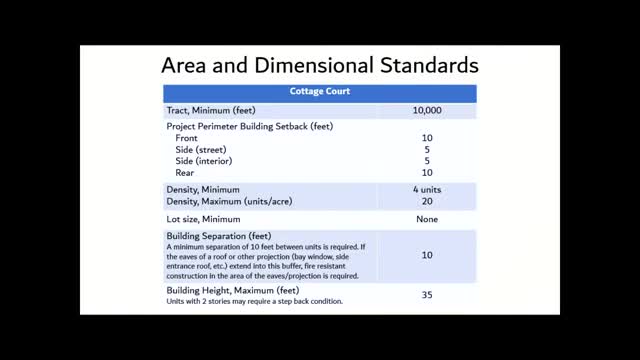Housing shortage sparks innovative cottage housing solutions
November 14, 2024 | Waynesboro, Augusta County, Virginia
This article was created by AI summarizing key points discussed. AI makes mistakes, so for full details and context, please refer to the video of the full meeting. Please report any errors so we can fix them. Report an error »

In a recent government meeting, officials discussed new zoning regulations aimed at addressing the region's housing shortage and enhancing community safety through updated building codes. Key points included the establishment of a minimum separation of 10 feet between residential units, which is primarily driven by fire safety codes. If roof eaves or other projections encroach on this buffer, fire-resistant construction materials will be mandated.
The meeting also highlighted that building heights would be capped at 35 feet, with two-story units required to incorporate a step-back design to prevent overshadowing neighboring properties. Buffer requirements will be evaluated on a case-by-case basis during the conditional use permit process, allowing for tailored solutions that consider the unique characteristics of each parcel.
Additionally, the discussion touched on the findings of the SAW housing study, which confirmed a significant housing shortage in the area. The study revealed that while 65% of households consist of 12 or more individuals, 70% of the housing stock comprises units with three or more bedrooms. This discrepancy underscores the need for smaller housing options, particularly for one- and two-person households.
To address this gap, cottage housing has been introduced as an allowable use in the zoning ordinance. This approach is expected to facilitate the development of smaller, more affordable homes on vacant or redevelopable lots, thereby increasing density while minimizing public infrastructure demands. The planning commission has already reviewed and recommended approval of this ordinance, following a joint work session with the city council.
Officials expressed optimism that these measures will contribute to a more balanced housing market and better align with the community's needs. The meeting concluded with an invitation for further questions, emphasizing the collaborative effort behind these regulatory changes.
The meeting also highlighted that building heights would be capped at 35 feet, with two-story units required to incorporate a step-back design to prevent overshadowing neighboring properties. Buffer requirements will be evaluated on a case-by-case basis during the conditional use permit process, allowing for tailored solutions that consider the unique characteristics of each parcel.
Additionally, the discussion touched on the findings of the SAW housing study, which confirmed a significant housing shortage in the area. The study revealed that while 65% of households consist of 12 or more individuals, 70% of the housing stock comprises units with three or more bedrooms. This discrepancy underscores the need for smaller housing options, particularly for one- and two-person households.
To address this gap, cottage housing has been introduced as an allowable use in the zoning ordinance. This approach is expected to facilitate the development of smaller, more affordable homes on vacant or redevelopable lots, thereby increasing density while minimizing public infrastructure demands. The planning commission has already reviewed and recommended approval of this ordinance, following a joint work session with the city council.
Officials expressed optimism that these measures will contribute to a more balanced housing market and better align with the community's needs. The meeting concluded with an invitation for further questions, emphasizing the collaborative effort behind these regulatory changes.
View full meeting
This article is based on a recent meeting—watch the full video and explore the complete transcript for deeper insights into the discussion.
View full meeting
